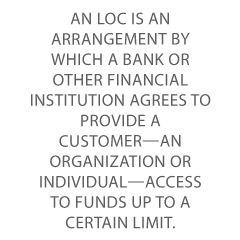The Best Ways to Use Your Business Line of Credit
A business line of credit (LOC) is a powerful tool to help business owners handle surprise expenses or navigate a dip in revenue. Having an LOC to draw from can be the difference between business failure and survival.
But like any money you borrow, LOCs must be repaid—with interest—so it’s important to think through the best ways to use this funding option.
Here’s what you need to know about a business LOC and how you should use it.
What, exactly, is a business line of credit?
An LOC is an arrangement by which a bank or other financial institution agrees to provide a customer—an organization or individual—access to funds up to a certain limit. The customer can draw funds up to that limit at any time and must pay interest on the amount borrowed until they repay it. After repayment, the customer can borrow those same funds again (and again) to cover further expenses.
A business LOC is different from other common business funding options in several ways. The option it most closely resembles is a credit card. This is since both of these function by allowing the borrower to draw money over and over up to a given limit. An LOC is unlike a credit card, in that an asset like a home or business property might secure it. This often leads to lower rates (traditionally 3% to 7%) and higher limits than credit cards.
Another common option for business funding is a business term loan. You might secure it with a business asset, as with an LOC. Unlike an LOC, though, a business loan is due in set installments that can range from three months to 25 years. While with an LOC, payment is typically due monthly on the amount you borrowed, and interest only accrues on what you don’t pay back on time.
What is a business line of credit best used for?
It is best to use business LOCs when you know you can back the funds relatively quickly. Hence business owners who lean on LOCs to finance regular business operations may quickly find themselves in trouble with repayment.
“A line of credit is meant to be a short-term bridge rather than a long-term fix,” says Matt Schulz, chief credit analyst at LendingTree. “It is meant to provide a consistent access to funds to help businesses push through short-term crunches, such as waiting for a client to pay an invoice or seasonal dry periods.”
When deciding whether to use an LOC for a given expense, err on the side of caution. You want to preserve borrowing capacity to maintain a safety net. But if the expense in question is the type that a safety net is made for, then borrow away. Here are five situations where you may want to consider using your business LOC.
Unexpected emergencies
An LOC can be a good way to respond quickly to a true emergency in your business. For example, a natural disaster that damages your property. Or the complete breakdown of vital equipment. You need to fix these problems right away. They may be expensive to address. But an LOC can accommodate this.
However, it’s best to think ahead about how you’ll repay the large expense quickly. This is to regain your borrowing power and reestablish your LOC safety net for the next time something comes up. In the case of a natural disaster, you may anticipate receiving insurance money that you can use to repay the LOC.
Equipment repairs
A small equipment repair is an excellent use case for a business LOC. It’s best to try to limit your use to repairs that are relatively inexpensive and quick. This is so that you don’t tie up too much of your credit limit for too long. That’s why it’s best to finance major, nonemergency repairs or the purchase of new equipment in another way, such as via a business loan.
“If you’re talking about new equipment altogether, [using a line of credit] might not be the best fit,” says Shulz. “Tying up the funds from a line of credit in a big equipment purchase means that there is less of it to use as a safety net in case cash-flow woes or other short-term financial hiccups occur.”
Ramping up
Using an LOC to help you pay for necessary expenses while you’re ramping up your business can be a good idea, assuming you’re sufficiently sure of success and anticipate being able to pay the LOC back by way of increased revenues in the near future.
Borrowing money from an LOC to start a business you’re unsure will succeed is an unwise choice. You’ll be liable for repayment even if the business fails.
Busy seasons
Some businesses have de facto busy seasons or are explicitly seasonal, which can put a strain on business resources at certain times of year. An LOC can help you cover all the expenses required to function optimally in the busy season. This is with the anticipation that revenues from those heightened sales will allow for quick repayment after higher sales ebb.
“The extra funds from the line of credit can help you handle those extra expenses while you wait for the cash to start rolling in during that busy period,” says Shulz. The key is ensuring that you have full confidence that the sales will indeed be rolling in soon.
Awaiting payment
An LOC can help when you’re waiting for payment—especially late payment—from a customer. Or when ramping up to handle an important new client. In both cases, you know money will be forthcoming, which will allow you to repay whatever you borrow very soon.
Just be sure that if you borrow from an LOC as an advance on forthcoming payment that you are absolutely certain that money will be coming along soon. You can get in hot water if you dip into your LOC only to have your client default on payment you’re expecting.
Secure an LOC before you really need it
Ideally, you should have an LOC set up before you need the money. Establishing a business LOC can require an initial investment — if the lender charges closing costs. So it may be hard to stomach setting one up before you feel you absolutely have to. But the security it provides is well worth the initial outlay.
“It can definitely be smart to get that line of credit before you really need it,” says Shulz. “Remember that you don’t have to use it when you get it. You’re only charged interest on the amount that you actually use.”
In a best-case scenario, you establish your LOC and never have to borrow against it. But you’ll sleep easier at night knowing it’s there.

Katherine Gustafson is a freelance finance and business writer specializing in content marketing and thought leadership. Her work has appeared in finance and business publications such as MagnifyMoney, StudentLoanHero, Forbes, and Business Insider.
The post Here’s When to Dip Into Your Line of Credit appeared first on Credit Suite.


